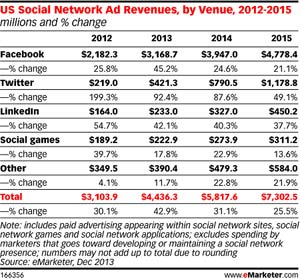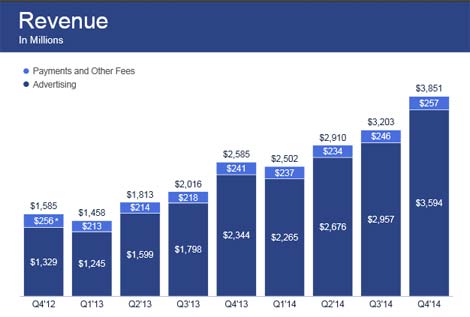
[This story was updated Feb. 20, 2015.]
Social media stocks are off to a good start in 2015, with Facebook Inc. (Nasdaq: FB) still leading the group.
Facebook's stock is up 14% over the past year to around $80 a share, and FB now has nearly the same market cap as Wal-Mart (NYSE: WMT). Facebook has 1.31 billion active users. And it released a "revolutionary" marketing platform that will challenge the likes of Google Inc. (Nasdaq: GOOG, GOOGL).
But a question that must be clear to investors is exactly how do social media companies make money?
To answer this, we turned to Money Morning E-commerce Director Bret Holmes. Part of Holmes' job is to utilize web advertising via social media platforms to best market Money Morning. As a result, he's on top of what's going on inside of today's social media giants.
Holmes said the key to unlocking value for social media companies is successful advertising models.
"Social media companies are legitimate advertising websites, no different than, say, Google or Yahoo. The same way Google made its money is the same way Twitter and Facebook will make their money," Holmes explained.
And web advertising via social media is a market that's growing at a staggering rate.
A 2013 Nielsen report (the most recent data) showed 89% of advertisers use free social media advertising and 75% use paid social media advertising. The report also highlighted that 64% of advertisers expected they'd increase their paid social media advertising budgets over the course of 2013. And BIA/Kelsey projected that total U.S. social media advertising revenue will grow from $5.1 billion in 2013 to $15 billion in 2018, for a compound annual growth rate (CAGR) of 24%.
McKinsey & Co. released a study in January 2015 that said 82% of companies have now adopted at least one social tool in their business. And 72% of firms expect that in the next three years, their organizations will invest more in social media - up 58% from a year ago. When surveyed on how they use social media, businesses listed the execution of marketing activities as one of the top three uses.
That means a lot of opportunity for social media companies to make major money.
How Social Media Companies Make Money: The Key to Unlocking Value
The trick for social media companies looking to profit as ad platforms is to find the best way to insert advertising into the user's experience without impacting the user in a negative way.

In fact, advertising methodology is one of the most important factors in determining a social media company's profitability...
In December 2013, marketing research firm eMarketer published revenue brought in by advertising for Facebook, Twitter, LinkedIn, and more. Based on data trends, it projected revenue values for 2014 and 2015. Total ad revenue raked in by these social media companies are expected to more than double from 2012 to 2015.
Ad spending on mobile is of special importance to social media companies. That's because every year, ad spending on mobile has increased significantly. In September 2014, eMarketer predicted that U.S. mobile ad spending will jump 76.7% from 2013 ($4.92 billion) to 2018 ($25.69 billion).
Exemplary of the profitability of tapping into mobile growth is Facebook. On Jan. 28, 2015, Facebook reported its most recent earnings. Mobile ad revenue alone in fourth quarter 2014 came in at a mammoth $2.477 billion. And mobile ad revenue represented about 69% of all ad revenue for the quarter. That was up from 53% of total ad revenue in the Q4 2013, and up from 30% of ad revenue in Q1 2013.
This kind of advertising success is tied directly into a social media company's bottom line - and its profitability for investors.
To learn how to gauge which companies will succeed, here's how social media advertising actually works...
How Social Media Companies Make Money: A Lesson from Facebook
 The Facebook IPO was an unmitigated disaster. It lost over half of its value within six months of listing, and was priced at 107 times trailing 12-month earnings, making it pricier than 99% of all companies in the S&P 500 at the time.
The Facebook IPO was an unmitigated disaster. It lost over half of its value within six months of listing, and was priced at 107 times trailing 12-month earnings, making it pricier than 99% of all companies in the S&P 500 at the time.
But boy did it rebound.
From July through September 2013, the Facebook stock price more than doubled. Shares are up more than 210% over the past 24 months. As of Feb. 20, 2015, FB stock traded at $79.89 - putting it $41.89 over its IPO price of $38.
It was advertising that undoubtedly turned the tides for Facebook.
"Facebook has gotten really good at advertising. It's new, it's inexpensive, and it's smartly done," Holmes said. "When Google first started, it wasn't good at advertising, and look at them now."
Here is what Facebook did to unlock its value and become what Holmes described as "the most advantageously competitive product on the market for advertisers, hands down"...
[epom key="ddec3ef33420ef7c9964a4695c349764" redirect="" sourceid="" imported="false"]
Originally, Facebook started with space ads. Then, it added self-promoting individuals' or a company's Facebook page. But things were still sluggish.
However, around the start of 2013, Facebook developed a new advertising format. They're technically referred to as native social ads - ads that are seamlessly integrated into the social media's platform. BIA/Kelsey projects social media native revenue as the fastest-growing social media advertising method at a 38.6% CAGR by 2018.
"Facebook has integrated in-stream ads to the user experience. Response rates are high and advertisers will always chase the least expensive ad with the best response. It works because it's new and cheap," said Holmes.
In-stream ads can be videos. For instance, a commercial will appear before the user may watch an Internet video. The in-stream video ad will typically last 15-30 seconds.
On a social media site like Facebook, which has real-time update feeds, in-stream ads can be inserted into a streaming feed. So, for example, the user scrolls through the News Feed to see what friends and family are up to, and in-stream ads are peppered into the Feed.
"For the first time in 2013, Facebook let advertisers access FBX, an ad exchange where you can customize your own ads," explained Holmes. "Now we can glean information and better target our audience. We can also advertise on mobile now."
The ad model is helping Facebook monetize its massive 1.393 billion monthly active users who increasingly access the site via mobile devices.
In FB's most recent quarter (Q4 2014, released Jan. 28, 2015) ad revenue reached $3,594 million - a 21.5% increase from the previous quarter, and a 53.3% increase from the same quarter a year ago.
 Facebook's not done there. On Sept. 29, 2014, it released for beta testing a new, upgraded ad platform called "Atlas." Holmes says Atlas will "revolutionize web advertising."
Facebook's not done there. On Sept. 29, 2014, it released for beta testing a new, upgraded ad platform called "Atlas." Holmes says Atlas will "revolutionize web advertising."
Atlas capitalizes on the personal nature of FB's site. It delivers people-based marketing instead of content-based marketing.
That makes a big difference in terms of an ad's effectiveness. (For more details on how Atlas works, go here...)
Watching Facebook's advertising Cinderella story shows us a great deal about how advertising makes money for social media companies.
Biggest IPOs of 2015: This past year was the biggest for the IPO market since the dot-com era of 2000 - and the market shows no signs of slowing down. According to Renaissance Capital, a manager of IPO-focused ETFs, there are currently 119 IPOs in the pipeline for 2015. Combined, those companies should raise roughly $23 billion. We've pinpointed the five biggest IPOs investors should watch in 2015...
Related Articles:


